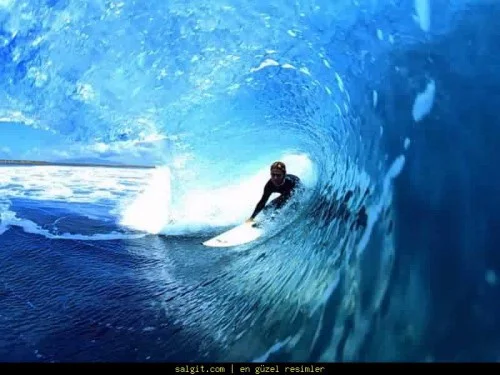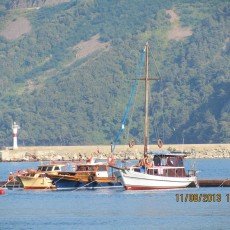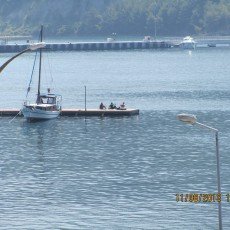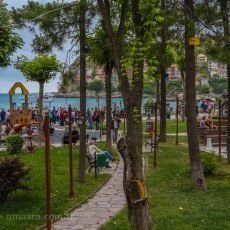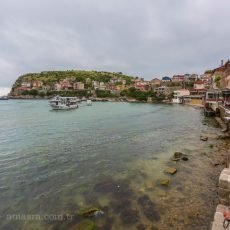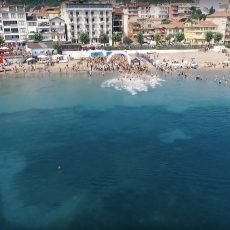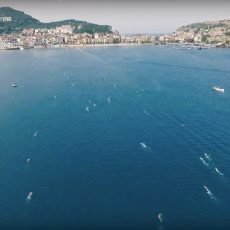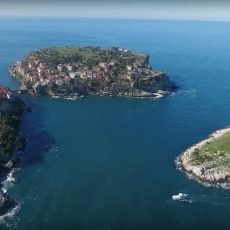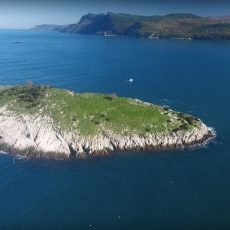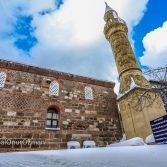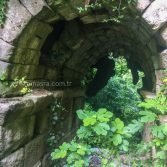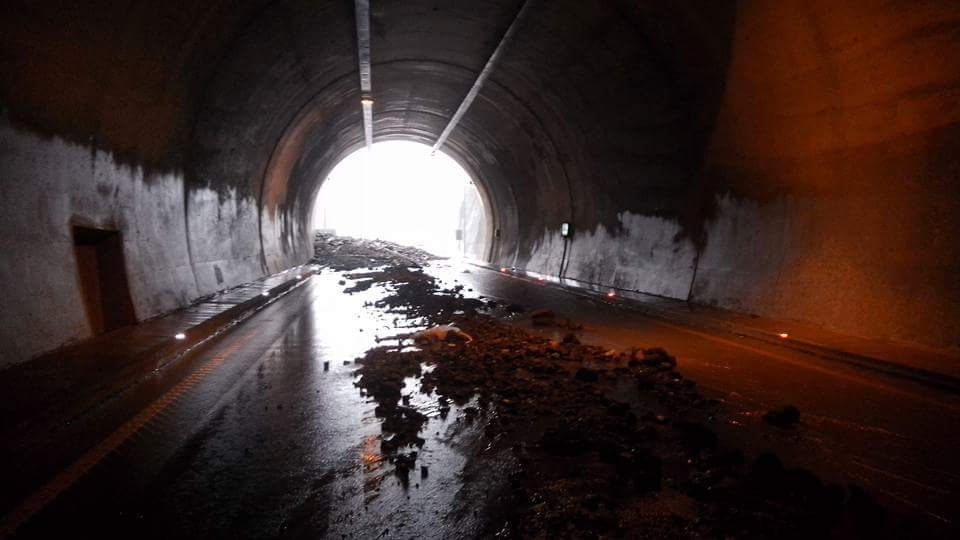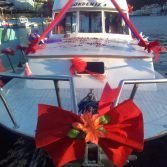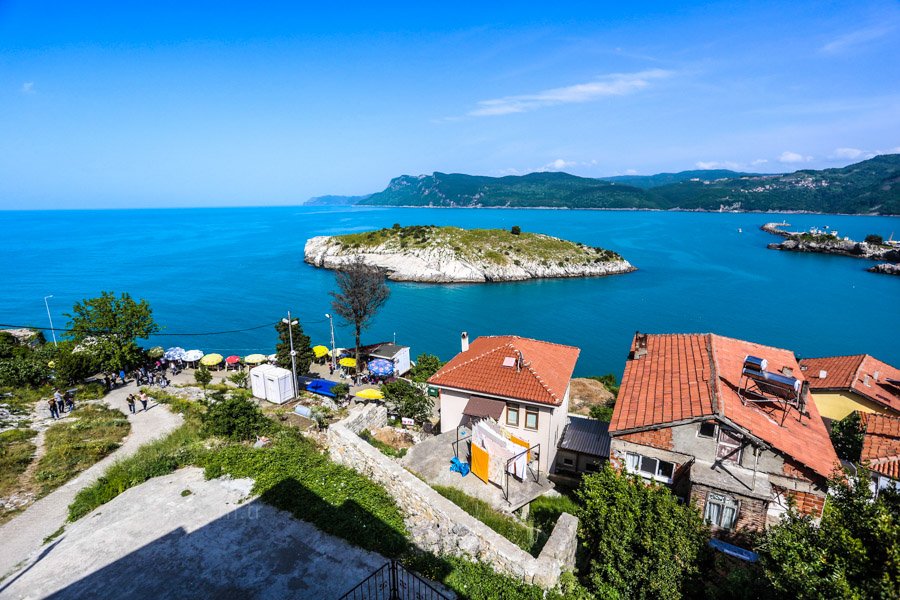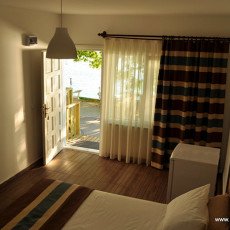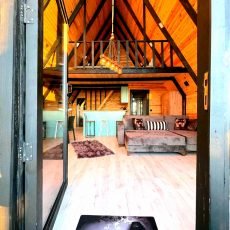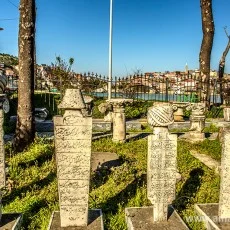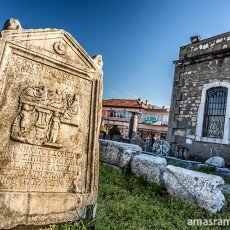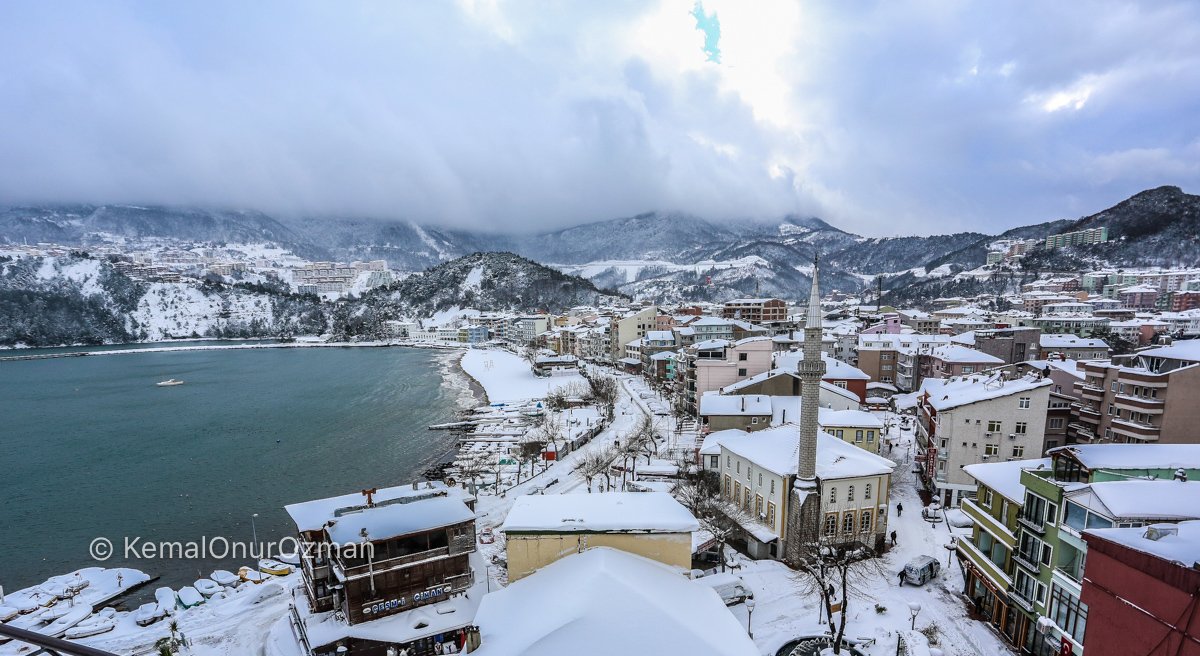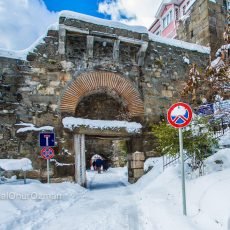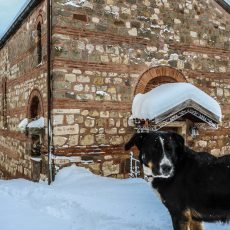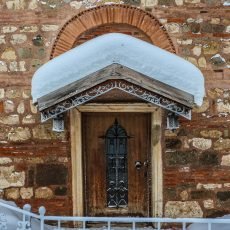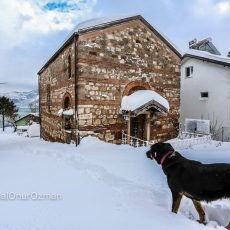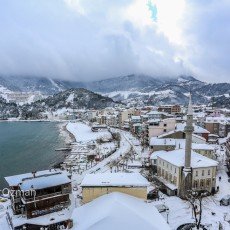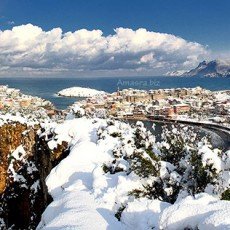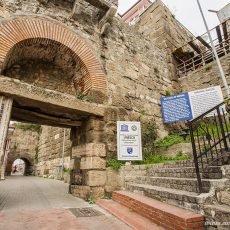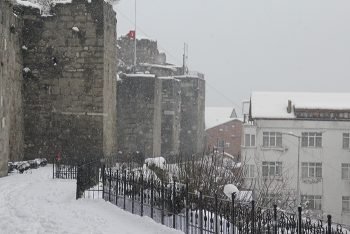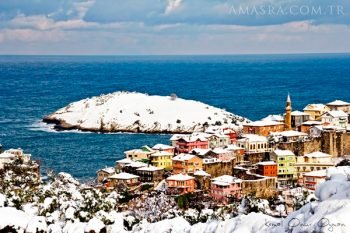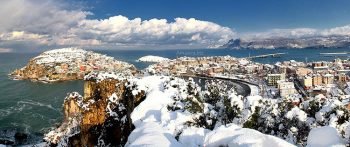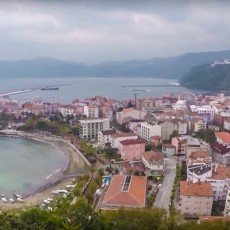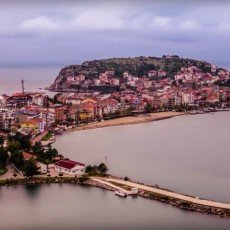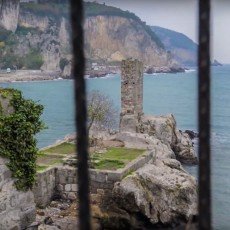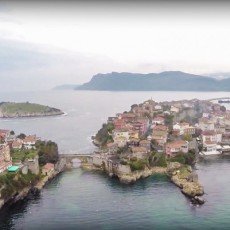Entrance
Amasra Castle is a building located in Amasra district of Bartın province on the Black Sea coast and stands out with its thousands of years of history. It is one of the most important historical heritages of the region, both for its defensive use and for the role it played in the commercial and cultural development of the city. The geographical location of the district also made the castle strategic: Amasra is on a sheltered peninsula with two natural bays running in opposite directions. This peninsula consists of Boztepe Island, connected to the mainland by an arch called Kemere Bridge, and the Kaleiçi (Dungeon) area on the mainland. Thanks to its natural harbors, Amasra has been a critical point for maritime trade and military strategy throughout history. As a matter of fact, Fatih Sultan Mehmet admired its beauty when he conquered the city and "Lala Lala, is this the Çeşm-i Cihan?" (Is this the eye of the world?), emphasizing the importance of the castle and the city. In 2013, Amasra Castle was included in the UNESCO World Heritage Tentative List within the scope of the file "Fortresses and Walled Settlements from the Mediterranean to the Black Sea on the Genoese Trade Route", and today it is being evaluated with the aim of preserving and transferring this cultural heritage to the future.
(File:Amasra, Turkey, Castle, view from the island.jpg – Wikimedia Commons) The location of Amasra Castle on the peninsula. The location of the castle created a safe harbor city on the Black Sea with two sheltered harbors extending to the east and west. This strategic geography reinforced the importance of Amasra from ancient times to the Ottoman period. On the peninsula surrounded by the castle, civilian settlements and historical structures integrated with the castle can be seen today. In the photo, the minaret of the Fatih Mosque (which was a church in the 9th century and converted into a mosque after the conquest) on the top of the peninsula can be seen. This situation indicates that the castle was a living space that contained traces of different cultures in addition to its military function.
Historical Process of Amasra Castle
Ancient Period and Roman Empire: It is accepted that the first settlement in the Amasra region dates back to the Sesamos colony established during the Phoenicians in the 12th century BC. This port city, known as Sesamos in ancient times, was even mentioned in the works of Homer. In the 4th century BC, Queen Amastris of Persian origin reigned here and gave her name to the city. Afterwards, Amasra was connected to the Pontus Kingdom in the 3rd century BC and to the Roman Empire in the 1st century BC. It is known that the city was fortified with walls during the Roman period and that Amasra Castle was first built during this period ((PDF) PROTECTION RECOMMENDATIONS FOR AMASRA CASTLE). In fact, some of the large cut stone blocks and Latin inscriptions seen on the castle walls today are the legacy of the Roman period. For example, the name "CEASAR" (Caesar) is engraved on a stone block on the walls to the south of the castle, indicating that a building stone from the Roman Empire period was reused in the castle (File:Amasra Castle Cezar inscription.jpg – Wikimedia CommonsFrom the Roman period onwards, the castle played a central role in the defence of Amasra and the city was surrounded by strong walls.
Byzantine Period: Amasra, which was incorporated into the Eastern Roman (Byzantine) lands in 395 AD after the Roman Empire split into two, continued its military, religious and architectural development, especially between the 7th and 15th centuries. Amasra Castle was expanded and strengthened during the Early Byzantine period; the majority of the castle mass that remains standing today dates to the Early Byzantine period. The large andesite block stones on the southern walls of the Kaleiçi (Dungeon) section were joined with fine white horasan mortar and are a typical example of an early Byzantine wall. During the Byzantine period, Amasra was a military base that protected the region from external attacks, as well as a religious center of bishopric. However, when the threats from the Black Sea increased in the Middle Byzantine period, additional fortifications were built in the castle. Indeed, after the raids carried out by the Russians on the Black Sea coast in the 9th century, new fortification walls were built in the Middle Byzantine period in order to strengthen the defense of the castle. It has been determined that smaller stones and thicker mortar were used in the walls built during this period compared to the Early Byzantine period, and that brick material was also used. Thanks to these fortifications in the Middle Byzantine period, the castle was made more resistant to attacks from both land and sea. However, some structures from the Byzantine period have not survived to the present day; many of the architectural works, especially palaces and churches from the reign of Queen Amastris and the later centuries of Byzantium, have disappeared over time. However, a Byzantine church (known as the Fatih Mosque) built in the 9th century inside the castle, which was later converted into a mosque, has survived to the present day.
Genoese Period: The Republic of Genoa, which increased its influence in the Black Sea with the weakening of Byzantium after the Fourth Crusade in 1204, made Amasra its own colony after the Nymphaion Treaty signed in 1261. From the 14th century onwards Samastro Amasra, known as Amasra, was an important port in the Genoese Black Sea trade network until 1460. During the Genoese period, repairs and additions were made to the castle fortifications, and especially the front (sea-facing) walls and main gates of the castle were strengthened in the 14th and 15th centuries ( AMASRA CASTLE | Culture Portal ). During this period, the Genoese used the castle not only for defense purposes but also as an administrative and trade center. Consuls appointed to Amasra by the Republic of Genoa and officials from the Galata (Pera) colony governed the city, which led to the reflection of Latin influences on social and cultural life. Some of the coats of arms seen on the castle walls today bear traces of this period. For example, there are coats of arms belonging to Genoese noble families and Latin inscriptions at various points of the castle. Among these coats of arms, the “Duke – Genoa – Consul” coats of arms representing the administrators of the Republic of Genoa stand out. During the Genoese period, Amasra was a lively port city dealing with wood, wheat, wine, fabric and slave trade in the Black Sea; thanks to the protection of its geographical location, it became an important stop on the maritime trade route between Istanbul and Crimea. However, with the conquest of Istanbul in 1453 and the transition of Black Sea trade to Ottoman control, Genoese Amasra also experienced its last period.
Ottoman Period and After: Fatih Sultan Mehmet annexed Amasra to the Ottoman lands in 1460, ending the Genoese rule that lasted for nearly two centuries. Since the city surrendered without a fight during the conquest, the castle was not severely damaged, and the Ottomans continued to use the existing walls. By Fatih's order, two large churches in the castle were converted into mosques (one of them is the Fatih Mosque today) and a judge was appointed to the city. In addition, after the conquest of Amasra, the people brought from the interior of Anatolia (especially from Eflani) were settled here, and the Turkish-Islamic population and culture became established in the city. During the Ottoman period, Amasra maintained its administrative importance as a district center of the Bolu Sanjak; however, since the Ottomans took control of the Black Sea trade routes with the conquest of Istanbul, Amasra's role in international trade gradually decreased. Although the castle continued to be used for regional security in these centuries, it did not witness large-scale military conflicts. Thanks to this, the castle walls and structures remained relatively intact for a long time. Travelers who visited Amasra in the 17th and 18th centuries praised the beauty of the city and the castle in their works; the castle walls, which had a "medieval atmosphere", aroused admiration in visitors with the coats of arms and figures on them.
Structures that have survived to the present day: The parts of Amasra Castle that can be seen today are the result of its multi-layered historical process. The castle is located on the Boztepe (island) side. Sormagir Castle, the other on the peninsula Dungeon Castle It consists of two main masses: AMASRA CASTLE | Culture Portal These two masses are connected by the Kemere Bridge, dating from the Roman-Byzantine period (Kemere Bridge – WikipediaThe total length of the castle walls is approximately 1700 meters and some sections have survived completely and some partially ((PDF) PROTECTION RECOMMENDATIONS FOR AMASRA CASTLE). On the Sormagir (Boztepe) side, there are no fortification walls on the north and west sides due to the protection provided by the natural cliffs; on the east and south sides, the six-bastion south line and the five-bastion north line have survived to the present day. Zindan Castle on the peninsula side has a more regular rectangular plan; while the south and east walls are largely intact, the north walls are represented by only the remains of a tower due to sea damage, and the west walls are partially collapsed. Among the surviving parts of the castle, notable structures are the Fatih Mosque (former Byzantine church), the remains of a small chapel, water cisterns, the remains of civil architecture within the walls, and areas where various ancient architectural pieces (column capitals, sarcophagus fragments, etc.) are seen. The current condition of the castle was documented with the works carried out in the 2010s; conservation works were accelerated with the inclusion of Amasra Castle on the UNESCO World Heritage Tentative List in 2013. Today, Amasra Castle stands with all its historical layers extending from the Roman to the Ottoman Empire, and offers visitors an “open-air museum” experience.
Castle Gate and Its Architectural Features
General Architectural Structure: Amasra Castle exhibits an integrated defense system consisting of two structural sections and a bridge connecting these sections. Sormagir Castle on Boztepe Island and Zindan Castle on the peninsula, a single-eyed stone bridge built over the narrow strait between them. Kemere Bridge The Kemere Bridge was founded as a Roman period structure and took its current form in the 9th century during the Byzantine period (Kemere Bridge – WikipediaThe bridge not only provides defensive integrity by structurally connecting two castle parts, but also enables passage between two ports with an arch opening under which boats can pass. The plan of the Boztepe (Sormagir) side is in the shape of a crescent (arc) and there was no need to build walls on the northern and western ends of the island, which are surrounded by steep slopes to the sea. On the southern and eastern sides of the island facing the land, there is a line of walls supported by six semicircular towers. These walls are reinforced with an outer defensive wall called “hisarpeçe” at ground level. The transition point from Boztepe Castle to the main peninsula and “DarkgateThe passage referred to as "The Gate" has double doors, one on the outside and the other on the inside, and is in the form of a vaulted corridor. The construction of the Dark Gate in two stages is a solution applied in classical castle architecture to increase defense.
Zindan Castle on the peninsula, ca. a rectangular inner castle Zindan Castle has long walls overlooking the sea on the east and south sides and is fortified with a total of seven towers. The walls on the north side have largely collapsed due to the strong waves and winds of the Black Sea; today, only “Little Tower"The ruins of a tower called " have survived. On the west side, there is a gate leading to the Zindan neighborhood “Outer West Gate” There is a main entrance gate known as the . It is understood that there was a second gate inside the walls in the inner courtyard that welcomes those entering from this gate (it is called the "Inner West Gate" due to the ruins). Research has shown that the Outer West Gate was built in the Middle Byzantine period (probably 9th-10th century), while the foundations of the Inner West Gate are older, dating back to the Early Byzantine period. In other words, the main gate area on the land side of the castle was renovated and strengthened in different ages and has been used. Approximately 50 meters of the western walls defending the Outer West Gate are still intact today. This section was continuously repaired until the Ottoman period because it was the last obstacle against the enemy approaching the castle from the land side.
Castle Gate and Decorations: The main entrance gate and other passages of Amasra Castle attract attention with the inscriptions and motifs they contain, as well as their functionality. There are relief figures and inscriptions placed on the castle walls in various periods. The inscriptions added to the castle, especially during the Genoese administration, bore both coats of arms and included inscriptions documenting the construction/repair dates. The 1910 research of French archaeologist F. W. Hasluck, He recorded in detail the Genoese coats of arms and inscriptions on Amasra Castle. Some of these inscriptions contained the names and coats of arms of Genoese rulers (for example, the coats of arms of the famous Genoese families Doria or Boccanegra). However, over time, some of them were removed and taken to the museum or eroded by natural factors. However, there are still a few coats of arms reliefs visible in the castle. Genoese coats of arms, are stone slabs with Latin inscriptions, mostly surrounded by cross and shield motifs. One of these is a coat of arms indicating the title of the Genoese ruler of Amasra, which can be seen on the southern wall of the castle. In addition, sculptures and reliefs from the Roman period are placed at different points of the castle. For example, on a marble block Eros (God of Love) relief, on another stone Medusa The head motif can be distinguished. The presence of such ancient mythological figures in the castle probably stems from the fact that materials (spolia) taken from old temples or structures in the region were placed on the castle walls for secondary use during the Byzantine period. Apart from these, eagle relief And ox head Figures such as have also been reported.
In the immediate vicinity of the castle gate and in the lower part of the city walls, there are also inscribed blocks from the Roman period that attract attention. One block in particular has Latin inscriptions on it. “CEZAR” The letters of the phrase are seen (File:Amasra Castle Cezar inscription.jpg – Wikimedia Commons). This inscription is most likely part of an inscription prepared to commemorate the Roman Emperor or a member of his family and was used as a building block in the wall during the construction of the castle. The inscription in question remains in place on the castle wall today and can be seen by visitors. This example shows that there are traces of different civilizations even in the stone material of the castle. Although there is no visible decoration left on the vault stones and jambs of the castle gate today, it is thought that in the past it may have had colorful Byzantine cross motifs or an inscription added during the Ottoman period. Some Western travelers who visited the castle in the late 19th century stated in their notes that there was an Ottoman inscription on the gate. Although it is thought that this inscription may have belonged to one of the restorations after the conquest, no such inscription remains today.
Conservation and Restoration Works: The castle gate and walls have been the subject of various conservation interventions in the late 20th and 21st centuries. With increasing awareness, especially in the 2010s, urgent repairs were carried out in certain parts of the castle. In 2014, a project prepared by the Bartın Special Provincial Administration restored approximately 30 meters of the castle walls. During this restoration, the walls around the castle gate were also strengthened by cleaning vegetation and grouting. In 2017, a comprehensive maintenance and repair work was carried out in the parts of the castle that were at risk of collapse under the coordination of the Ministry of Culture and Tourism. In this work, the cracks around the arch bridge and the gate entrance were filled, and the uncontrolled vegetation surrounding the walls were cleaned. In addition, the rubble that had accumulated over the years on the inner part of the western walls where the castle gate is located was removed, allowing the structure to breathe, and revealing the silhouette of the gate. Today, periodic checks are carried out for the protection of the castle gate and walls; crack monitoring is continued, especially in the gate arch and its surroundings. In line with the goal of including the castle on the UNESCO permanent heritage list, comprehensive projects are being prepared for the restoration of the gate and walls in accordance with the original. In this way, it is aimed to transfer all the elements of Amasra Castle, from the entrance gate to the bastions, to future generations.
Nations and Cultural Influences That Lived in the Castle
Roman and Byzantine Influences: Amasra Castle carries the traces of the civilizations that ruled over it layer by layer. The legacy of the Roman period can be felt in the castle's basic plan and some of its building blocks. Large cut stones, products of Roman engineering, and brick beams seen here and there constitute the oldest layers of the castle. Another important trace left by Roman culture in the castle is the Latin inscriptions. The "Cezar" inscription mentioned above is a reflection of Roman political sovereignty and imperial cult. Another Latin inscription found in the castle was found with a line starting with the letters "JUL", which is thought to be part of a text that probably praises Julius Caesar or another emperor (this piece is in the Amasra Museum today). During the Byzantine period, the influences of Christianity and Eastern Roman aesthetics were added to the Roman heritage. The existence of a church from the Byzantines inside the castle (which has survived to the present day as the Fatih Mosque) is evidence of the religious and architectural influence of Byzantium. This church, dating from the 9th century, has a typical basilica plan and the brick and stone alternating wall technique specific to Byzantine architecture can still be seen in the apse section. In the sections of the walls added to the castle during the Byzantine period, the military architecture of the period can be seen: The wall structure, built with smaller stones and containing broken bricks in the mortar, is characteristic of Middle Byzantine castle architecture. In addition, the Byzantines strengthened the weak points of the castle (such as the northern walls and the passage points) with additional fortifications against threats to the city. An example of this is Karanlıkkapı; during the Byzantine period, the existing natural tunnel was widened and double-doored, increasing the defense. The Byzantine cultural influence continues not only in architecture but also in terminology: The section within Amasra Castle, popularly known as the “Zindan”, takes its name from the dungeon structure of the Byzantine period. Although this structure does not exist today, its name continues to live on. As a result, the castle inherited a religious structure (church/mosque), some inscriptions, architectural techniques and place names from Byzantium.
The Genoese (Genoa) Period and Commercial Culture: From the mid-13th century to the 15th century, Amasra was a Genoese colony under the influence of Italian maritime trade culture. In addition to using the castle as a military garrison, the Genoese turned the city into a station in the Black Sea trade network. During this period, Italian merchants, soldiers and administrators lived in Amasra; therefore, traces of Latin culture began to be seen in and around the castle. Language and management: Official correspondence and inscriptions were written in Latin, and Genoese consuls governed the city from the administrative center inside the castle. The appointments of these consuls were made in Genoa, and Catholic priests and officials from Pera (Galata) were also included in the local administration. As a result, the Latin language and Catholic faith dominated the castle and the city for a while. Architectural contributions: The Genoese added several new structures to the castle, including the Zindan Castle Genoese Castle The inner castle section is called. The walls of this inner castle, which form a separate elevation within the castle, are built with small rubble stones and durable pink horasan mortar and reflect the typical construction techniques of the Genoese period. In addition, buttresses were added to the weak parts of the city walls and some bastions were repaired. Artistic and cultural traces: Although most of the buildings built in the castle and the city during the Genoese period do not survive to this day, the family coats of arms on the castle walls reflect the Genoese understanding of art. For example, a shield-shaped coat of arms relief has a cross figure and a Latin motto engraved on it – this is probably a reference to San Giorgio, the patron saint of the Republic of Genoa. As part of the Genoese commercial culture, the port of Amasra Castle became famous for activities such as slave trade, timber export, wine and salt trade. Thanks to this trade, the city became rich and luxurious residences appeared in the castle. Findings such as imported ceramic pieces and Venetian gold coins in the castle during archaeological excavations show the liveliness of international trade. It is thought that the Genoese may have built a chapel or small church in the castle due to their Catholic faith; in fact, in addition to the Byzantine church, foundation traces of another religious structure that can be dated to the Genoese period were found in the castle (it is considered by archaeologists as the remains of a small chapel). In summary, during the Genoese period, Amasra Castle became part of a chain of trade colonies extending from the Mediterranean to the Black Sea, bringing Latin culture to the Black Sea coast in the process. Some terms of the Genoese language (Ligurian dialect) were also used among the people, for example, the local pronunciation of the word "castello" for castle was noted by travelers.
Ottoman and Turkish-Islamic Influences: Amasra Castle, which came under Ottoman rule from the 15th century onwards, witnessed a different cultural transformation during this period. The religious buildings remaining from the Byzantine and Genoese periods inside the castle were converted into mosques and new living spaces were built. The most important transformation was the conversion of the large Byzantine church inside the castle into a mosque by Fatih Fatih Mosque In this mosque, in accordance with the tradition of conquest, the practice of reading the sermon with a sword every Friday was introduced and this custom continued for centuries. This shows that a symbolic ritual applied by the Ottomans in the castles they conquered was kept alive in Amasra. During the Ottoman period, additions belonging to Turkish-Islamic architecture were also made in the castle. For example, a fountain (ablution fountain) and a small Madrasah It is understood from archive records that it was added. In addition, as the castle became intertwined with civilian life, examples of Ottoman residential architecture increased within the walls. Wooden Turkish houses were built within the castle in the 17th-19th centuries, and although some of them have not survived to the present day, traces of their foundations can be followed. The Ottoman administration also used the castle for military purposes: 19th-century documents indicate that a small military unit was stationed here and that the castle was used for a period arsenal It shows that it served as a fortress. The loopholes seen in some parts of the castle walls suggest that it was modified to fit firearms during the Ottoman period. Islamic motifs are also seen in the castle as part of Ottoman culture. For example, in the repairs made to some door arches and interior spaces, verse inscriptions It was placed there; an Ottoman traveler who visited Amasra in the 1880s noted that a verse from the Conquest Sura was written on a marble plaque over the castle gate. However, this plaque is no longer in place today; it was probably removed in the early 20th century. Perhaps the most enduring legacy of the Ottoman period was the Turkish place names and traditions. The neighborhood inside the castle was called the “Kaleiçi Mahallesi”, and the Boztepe side was called the “Ada Mahallesi” among the public. These names still survive today. Culturally, Amasra Castle was no longer a military structure during the Ottoman period, but rather a living space As it became a castle, daily life continued within the walls of the castle, and thanks to this, the castle structure has been preserved and has survived to the present day.
Repairs Seen in Different Periods
Historical Restorations and Repairs: Amasra Castle has undergone numerous repairs and additions throughout its nearly 2000-year history. The first construction began in the Roman period, and the castle was continually repaired and strengthened in response to different needs during the Byzantine, Genoese and Ottoman periods.(PDF) PROTECTION RECOMMENDATIONS FOR AMASRA CASTLE). During the Byzantine period, especially in the 8th and 9th centuries, when the castle walls were subjected to external attacks, large-scale renovations were made. Amasra Castle was also renovated within the scope of the imperial administration's program to fortify the Black Sea coast after the Russian raids in the 860s. In this context, a front wall (hisarpeçe) a second line of defence was added to the interior and passages such as the Karanlıkkapı were built. Traces of these repairs, dating to the Middle Byzantine period, can be seen on today's walls. For example, a different wall structure is seen, built with smaller rubble stones on top of the large stone blocks in the Early Byzantine walls; this shows that the wall techniques of the two different periods were combined. Again, some of the castle bastions were renewed during the Byzantine period. It is thought that there were repair activities in Amasra Castle, which came under the control of the Greek State of Trebizond for a short time in the early 13th century (however, since this period was short, there is no documentation).
By the Genoese period, the castle had experienced its second spring. In the 14th and 15th centuries The Genoese repaired the castle extensively to defend their Black Sea trading colonies ( AMASRA CASTLE | Culture Portal ). In the 1350s, correspondence between the Genoese governors of Sinop and Amasra mentions the strengthening of the castles. In line with this, the outer walls of Amasra Castle were repaired, the bastions were reinforced, and the approach points of the arch bridge were fortified. Since the inscriptions bearing the Genoese coats of arms document the dates of the repairs, we understand the years in which interventions took place. For example, an inscription found in the castle mentions a repair in 1449, which is a Genoese repair just before Fatih's conquest. Again, in the mid-15th century, it is mentioned in Venetian sources that the Genoese Commander Jacopo di Promontorio strengthened Amasra against Turkish attacks. This information shows that efforts were made to keep the castle as strong as possible until the conquest.
During the Ottoman period, although the castle lost some of its strategic importance, it was not neglected. Since there was no major damage to the castle walls after the conquest in 1460, it is understood that only minor repairs were made during the Fatih period. However, over time, some sections were ruined by natural conditions and neglect. When coastal castles regained importance, especially in the 18th century against increasing smuggling activities in the Black Sea, repairs were made to Amasra Castle. Ottoman archive documents record that in a report written to Istanbul by the Amasra Dizdarı in 1747, he requested funds for repairs to some parts of the castle. Accordingly, it is learned from the fortification registers that the necessary repairs were made to the castle walls at the end of the same year. Although small castles like Amasra fell into the background with the modernization of the Ottoman navy in the 19th century, local administrators made efforts to keep the castle standing. In 1887, the Fatih Mosque inside the castle underwent significant repairs, and the walls around the mosque were also overhauled. Especially the upper parts of the southern wall, which is right next to the mosque, were raised and rebuilt with bricks (this part can be seen with its different material today). In the last period of the Ottoman Empire, a note was made in the yearbook of 1904 stating that “Amasra Castle has fallen into disrepair, efforts are being made to preserve the existing castle” and a budget was requested to be allocated for the castle. However, this attempt was unsuccessful due to the collapse of the empire.
Modern Period Repairs and Current Status: Although Amasra Castle did not attract much attention in the Republican period, conservation awareness has increased since the late 20th century. When Amasra was declared an urban protected area in 1976, the castle was placed under legal protection; the castle and its surroundings were registered in the conservation zoning plan prepared in 1988 and new construction was restricted. However, despite these measures, uncontrolled construction in the castle and especially the construction of civilian residences adjacent to the walls continued for years. This has been identified as one of the most serious problems damaging the castle walls. By the 2010s, structural problems emerged in certain parts of the castle that required urgent intervention. In particular, the collapse of the rocks under the walls on the Boztepe neighborhood side towards the sea threatened the integrity of the structure. As of 2012, deep cracks were observed in the bastions of the castle and in 2015, a section of the walls collapsed. Upon these developments, restoration projects were prepared and put into practice under the supervision of the General Directorate of Cultural Heritage and Museums. In the first phase of restoration, which started in 2014, a 30-meter section of the southern walls of the castle was repaired; in the second phase in 2017, weak wall lattices were strengthened, soil deposits at the bottom of the walls were cleaned and drainage was improved.
Today, the general condition of Amasra Castle has been stabilized with partial interventions, but it still contains elements of risk. The harsh north winds of the Black Sea and the salt water effect cause wear and tear, especially on the northern walls and bastions. In addition, vegetation (trees and vines) is a major problem on the fortress walls; their roots penetrate between the stones and weaken the structure ((PDF) PROTECTION RECOMMENDATIONS FOR AMASRA CASTLE). Periodic cleaning has been carried out in recent years to solve this problem, but the vegetation has not been completely brought under control ((PDF) PROTECTION RECOMMENDATIONS FOR AMASRA CASTLE) ((PDF) PROTECTION RECOMMENDATIONS FOR AMASRA CASTLE). Since 2018, a comprehensive restoration and landscaping project has been prepared for the castle with the coordination of Bartın Governorship and Amasra Municipality. The goal of permanent entry into the UNESCO World Heritage List directs these works. Within the framework of the prepared “Amasra Strategic Action Plan”, actions have been determined for the short, medium and long-term protection of the castle. Among the priority suggestions, a buffer zone Preventing construction by creating a castle, destroying plants that gnaw at the walls, repairing weak parts with original materials and arranging signboards/routes to introduce the castle ((PDF) PROTECTION RECOMMENDATIONS FOR AMASRA CASTLE) ((PDF) PROTECTION RECOMMENDATIONS FOR AMASRA CASTLE). In addition, a documentation archive was created by making three-dimensional scans of the castle. Finally, after events such as the earthquake and storm that occurred in Amasra in 2021, the castle was re-examined and emergency response teams were formed.
Thanks to all these restorations, Amasra Castle has managed to survive to a large extent today. The city walls, where architectural techniques from different periods are intertwined, are examined like an open laboratory; restoration experts prepare intervention plans according to the characteristics of each layer. This multi-layered structure is, in a way, one of the most valuable aspects of the castle, and the main goal in conservation work is to preserve these layers and pass them on to future generations.
Conclusion
Amasra Castle, although built on a small peninsula on the Black Sea coast, is a structure of worldwide importance with its historical heritage. In the process extending from ancient times to the present day, the castle has carried the traces of different civilizations such as the Phoenicians, Romans, Byzantines, Genoese and Ottomans. In this respect, Amasra Castle has become the meeting point of the Mediterranean and Black Sea civilizations; a story of each period has accumulated in its walls and structures. Elements such as the Latin imperial inscriptions on the castle walls, Byzantine stonework, Genoese coats of arms and the Ottoman era mosque, multicultural identity This castle is not only a military structure; it has also been a "castle-city" where people lived, worshipped and traded for centuries.
Today, the preservation of Amasra Castle is of great importance both for Türkiye’s cultural heritage and for humanity’s shared history. Its inclusion on the UNESCO World Heritage Tentative List in 2013 shows that this value has been registered at an international level. Preserving the castle means preserving all the historical layers it contains – in other words, a time tunnel extending from antiquity to the Ottoman Empire. The restoration and maintenance works carried out with this awareness aim to both preserve the original architectural details and ensure the physical continuity of the structure. Amasra Castle is also a symbol of identity for the local people: It has been engraved in the people’s memory as an indispensable part of the city’s silhouette for centuries.
As a result, the studies and analysis presented on Amasra Castle reveal the historical importance of this structure and the transformations it has undergone in depth. The adventure of the castle from ancient times to the present makes it an important part not only of Amasra but also of the world's cultural heritage. For this reason, the castle is a value that deserves to be called "Çeşm-i Cihan" and deserves all the protection efforts to be passed on to future generations. Amasra Castle is a cultural heritage Its meticulous preservation is an expression of respect for the past and one of the most precious gifts to be left to the future.
Kemal Onur Ozman
Czech University of Life Sciences Prague, 2025
Source:
- Burak, Nurhilal (2020). “Conservation Proposals for Amasra Castle.” Black Sea Studies Journal, 105-118. (The history of the castle, construction techniques and conservation suggestions are discussed in detail in the article) ((PDF) PROTECTION RECOMMENDATIONS FOR AMASRA CASTLE).
- Hasluck, F. W. (1910). “Genoese Heraldry and Inscriptions at Amastra.” Annual of the British School at Athens, 17: 132–144. (This 1910 study is one of the first academic studies documenting the Genoese coats of arms and inscriptions on Amasra Castle).
- Eyice, Semavi (1966). History of Amasra (book). (A comprehensive work covering the history of Amasra from ancient times to the Ottoman Empire in chronological order; focuses on the castle's Byzantine churches and structures such as the Fatih Mosque).
- Bartın Provincial Directorate of Culture and Tourism (2020). “Amasra Castle” Culture Portal page ( AMASRA CASTLE | Culture Portal (Contains official information about the introduction, physical features and history of the castle).
- UNESCO World Heritage Center (2015). “Trading Posts and Fortifications on Genoese Trade Routes from the Mediterranean to the Black Sea”(The nomination file for Genoese trading colonies, which also included Amasra Castle, emphasizes the importance of the castle during the Genoese period).
- Anadolu Agency (2018). “UNESCO Permanent Heritage List Mobility in Amasra”. (News text provides up-to-date information on the castle's UNESCO process and conservation efforts).
- Archaeological News (2019). “Collapsed Rocks Under Amasra Castle Cause Concern”. (The news provides information about the physical problems of the castle and the recent repairs).
- Western Black Sea Development Union (2015). “Amasra”. (Summarizes the historical and cultural importance of Amasra Castle in general terms; tells the words of Fatih and the Genoese period with anecdotes).




























